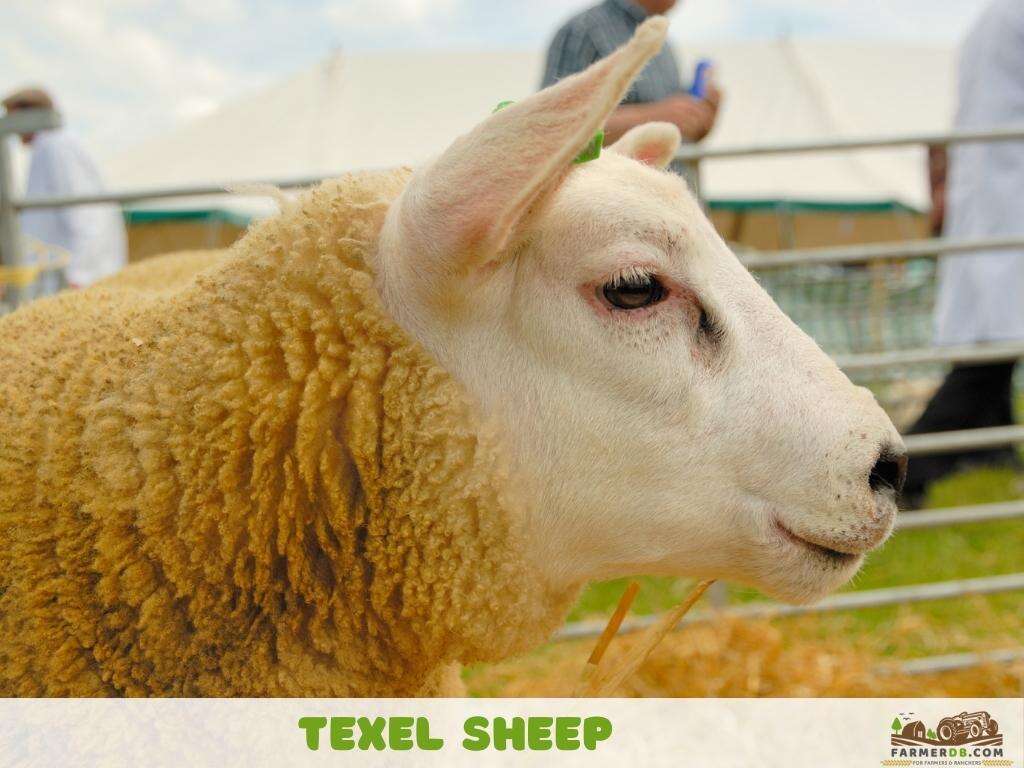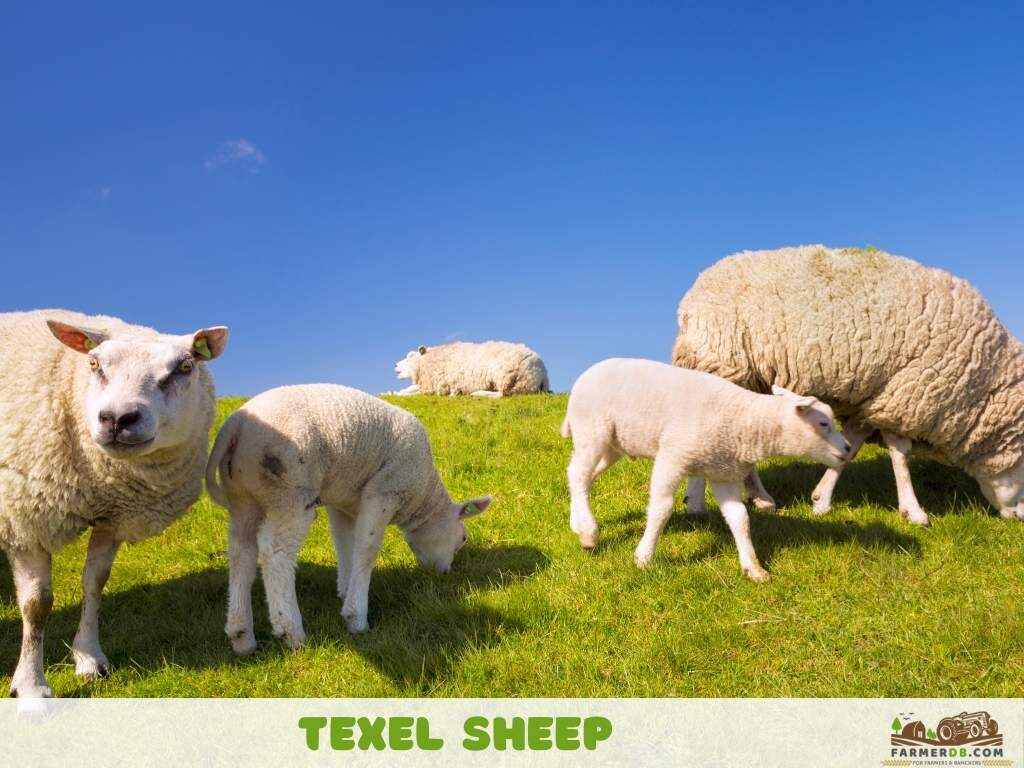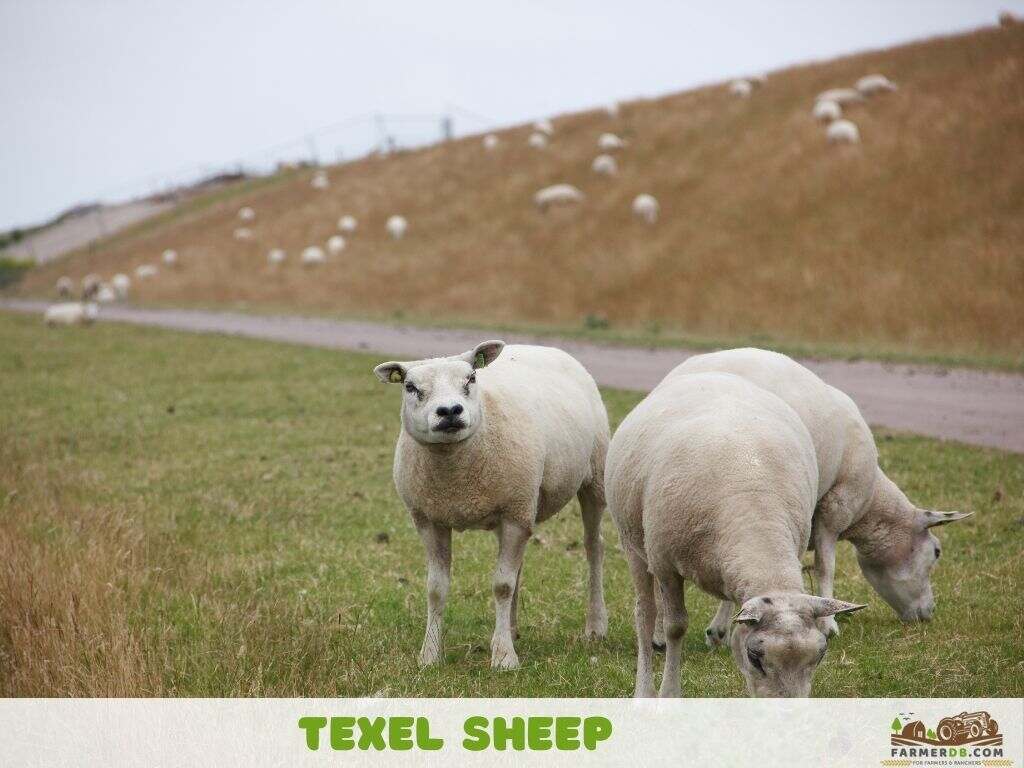Texel sheep are a domesticated breed, with their primary usage being meat production.
The sheep originates from the island of Texel in the Netherlands, where it was first developed in the early 19th century. Over the years, it has been enhanced through crossbreeding with other sheep to produce a robust and resilient breed.

There are a few types of Texel sheep, depending on where they are bred. For example, there are British Texels, French Texel, Dutch Texels, and even American Texels.
There is also a variation of the Texel breed known as the Blue Texel. The unique blue-gray coat color of the Blue Texel results from a genetic variation, making it stand out from the standard white Texel sheep. But, they share many characteristics with the standard Texel.
Each type is slightly different because of the conditions where they are raised, but all Texels share similar traits, such as a strong body and good meat production.
Texel sheep are very popular in many countries, especially in Europe, Africa, North and South America, and Australia.
Contents
Characteristics
Colors
These sheep are white or cream-colored.
British Texels may have occasional black spots on the nose, ears, or eyelids, which are acceptable breed traits.
Head
The head is clean and free of fleece, covered instead with fine white hair. It has a wide, strong forehead, smooth pinkish skin, and is slightly larger compared to the well-proportioned rest of the body.
In pedigree British Texels, the nose is preferably black.

Horns
This sheep breed is naturally polled.
Face
The face is free of wool, short, slightly curved in profile, and features clear eyes.

Neck
The neck is muscular, thick, and blends smoothly into the shoulders. It is usually covered with short fleece but remains less woolly compared to the main body.
Shoulders
The shoulders are broad and muscular, covered with a dense fleece that extends seamlessly into the body.
Body
The body is robust and well-muscled, covered with a thick, even fleece. The fleece stops before reaching the lower parts of the legs.
Texel sheep are considered among the most heavily muscled meat sheep in the world.
Front and Back Legs
The legs are straight, strong, and well-positioned beneath the body. Below the knees and hocks, they are bare, revealing smooth pink skin, while the upper portions are covered with short fleece.
Size
Texel sheep have a medium size.
Males have an average height of 28 inches (70 cm), while females average 27 inches (68 cm).
Lifespan
They have a lifespan of 10 to 12 years, which falls within the average range, similar to breeds like the Barbados Black Belly sheep or Katahdin.
Growth Rate
How fast do they grow?
This sheep breed has a fast growth rate, with lambs gaining an average of 0.55 lbs (250 grams) per day.
By weaning at 12 weeks, lambs weigh around 55 lbs (25 kg).
Weight
Adult male Texel sheep weigh an average of 209 lbs (95 kg), while females average 165 lbs (75 kg). At birth, lambs weigh around 10.8 lbs (4.9 kg).
Their weight is comparable to other meat breeds, such as the Rough Fell and Herdwick sheep.
Slaughtered Time
You can prepare to slaughter these sheep when they are around 6 to 8 months of age.
At this age, they weigh around 90 to 110 lbs (40 to 50 kg), with a carcass weight of approximately 90 to 97 lbs (41 to 44 kg).
Their dressing percentage is 54%, which is considered acceptable.
Temperament
These sheep have a generally docile and calm disposition, which makes handling them straightforward.
Some say that Texel sheep can sometimes display unpredictable behavior, becoming feistier, less cooperative, or even slightly aggressive.
They are curious by nature, cooperative, and not easily excitable or nervous, which adds to their appeal for farmers.
As great grazers, they adapt well to a variety of landscapes. Ewes are recognized for their strong maternal instincts, ensuring high lamb survival rates, while rams can show more dominant behavior during breeding periods.
Meat
These sheep produce high-quality meat, a feature that makes them one of the most popular breeds in the Netherlands, where they account for around 70% of the national flock.
The standout feature of Texel sheep is their muscle development and leanness, which gives them a superior meat-to-bone ratio.
Their meat is lean, flavorful, and has a lower fat content, particularly in seam fat, which is the fat located between muscles and more difficult to trim during processing.
This low seam fat makes their meat easier to prepare and desirable for consumers seeking healthier, leaner meat options.
Research from Clay Center and the University of Wisconsin highlights the advantages of Texel-sired lambs over other breeds, such as American black-face sheep.
Texel lambs typically have a 6-10% larger loin-eye area, which is a key indicator of meat quality. Many Texel breeders use ultrasound scanning to measure loin-eye areas, with sizes of 4 to 5 square inches being common.
| Measurement | Average Value | Measurement Method |
|---|---|---|
| Fat Depth (in/mm) | 0.10 (2.6) | Ultrasound Scanning |
| Muscle Depth (in/mm) | 1.11 (28.2) | Ultrasound Scanning |
| Total Spine Length (in/mm) | 20.89 (530.5) | CT Scanning |
Raising
Feeding
High-quality grass pasture should make up the majority of their diet. You can let them graze on ryegrass, clover, and other nutrient-rich grasses to meet their feeding needs.
During seasons with limited pasture, you can feed them hay. Alfalfa is an good choice because it is high in protein, providing them with energy and helping maintain their health.
It is essential to always offer them access to clean, fresh water and provide a mineral block or loose minerals containing calcium, phosphorus, and selenium.
Texel-sired lambs have a one full leg score advantage over comparable breeds and less total carcass fat. Notably, Texel lambs require 15 lbs (6.8 kg) less feed than black-faced lambs to achieve 60 lbs (27 kg) of weight gain, highlighting their efficiency in feed conversion.

When it comes to grains, you can offer options like corn, oats, or barley. However, if your pasture is of high quality, grains may not be necessary.
Monitor their condition closely. If they are losing weight or looking thin, it indicates the pasture does not provide all the nutrients they need, and grains should be added to their diet.
Be sure to avoid letting them graze on toxic plants, so check your pasture regularly.
Finally, be cautious with excessive copper intake. Sheep are highly sensitive to copper, so ensure their diet is free of high-copper feeds.
Environment
They do well in pasture-based environments. Open grazing systems with well-drained soil and rotational grazing practices are ideal to maximize their growth and health.
Climate
Regions with mild summers and cold winters, like much of Europe, are ideal for Texel sheep. They are well-suited to consistent rainfall, which supports lush pastures.
They can also tolerate colder climates, as their dense wool provides good insulation. Surprisingly, Texels can adapt well to dry or semi-arid climates, provided proper management and conditions are in place.
Shelter
These sheep need access to shelter to ensure their well-being in various weather conditions.
Shelter protects them from extreme cold, heavy rain, and strong winds, which can cause stress or health issues. In hot climates, it provides shade to prevent overheating and heat stress.
Additionally, shelter is crucial during lambing to create a safe and comfortable environment for ewes and their lambs. Properly ventilated and dry shelters also reduce the risk of diseases like foot rot or respiratory problems.
Shearing
You need to be shear them at least once a year to maintain their health and comfort.
They have dense wool, which can lead to overheating, especially in warmer weather. Shearing helps them stay cool, promotes healthy regrowth, and prevents their fleece from becoming overly long or matted.
Shearing is done in the spring, just before the weather warms up, ensuring they remain comfortable during the summer and have enough time to grow a protective layer of wool before winter.
Optionally, some farmers shear ewes 3-6 weeks before lambing. This keeps the wool cleaner, makes it easier for lambs to nurse, and allows better monitoring of the ewe’s body condition.
How many sheep per acre?
You can raise 6 to 10 sheep per acre on good-quality pasture with continuous grazing.
By practicing rotational grazing, you can increase this number to 13 to 15 sheep per acre. However, if the pasture quality is poor, you should reduce the number of sheep accordingly.
Breeding
The breeding of these sheep is done through natural mating.
Texel sheep reach sexual maturity at around 5 to 7 months of age for both males and females. However, ewes are usually not bred until they are at least 12 to 18 months old to ensure they are fully developed and healthy for pregnancy.

The breeding season of mature Texel ewes lasts nearly 5 months.
This breed is quite fertile for both ewes and rams.
Texel rams are commonly used in breeding programs to improve the carcass quality of other breeds.
All you need to do is introduce them to each other.
Ewes give birth to 1 to 2 lambs per year, with twin births being common. They have a high rate of multiple births, although triplets are less frequent compared to twins.
The birth weight of Texel lambs is slightly higher than that of some other breeds. This larger size contributes to their good growth rates.
Texel sheep with elongated and narrow bodies should not be used for breeding.
Among farmers, this sheep breed does not have the best reputation when it comes to lambing. Ewes often have narrow hips, and the lamb’s head is so large that it can cause complications or even death during lambing. In the case of twins, it can be very challenging to save both lambs during delivery.
When it comes to mothering skills, Texel ewes are considered to have moderate maternal instincts. They are generally attentive to their lambs but might require some assistance in caring for them, especially during their first lambing season. Farmers often monitor lambing more closely with Texel ewes to ensure both the ewe and lambs are doing well.
Health Issues
These sheep have some specific health issues, including lambing difficulties (dystocia (see refs.) ) and Laryngeal Chondritis (see refs.), often referred to as Texel Throat due to its association with the breed.
Beyond these, they can also be prone to common sheep problems such as parasites, copper toxicity, flystrike, and foot rot.
Why should you raise it?
Advantages
- Efficient feed conversion
- Hardiness
- Good grazers
- High fertility
- Great muscle development
- High-quality meat
- Strong market demand
- Ability to tolerate all climates
Disadvantages
- Lambing difficulties
- Moderate mothering skills
- Prone to laryngeal chondritis
- Occasionally stubborn
References
- A review of dystocia in sheep link
- Laryngeal chondritis in Texel sheep link
- NTS and TsNH Dutch Texel Sheep Flock Book (NTS) link
- Texel Sheep Breeders Society – USA link
- World’s most expensive Texel sheep sold for £368,000 link
Do you have any experience with the topic discussed here?
Would you like to improve the information shared and contribute your practical knowledge on the subject?
Your real-world experience as a farmer or rancher could greatly benefit other members, and the community would deeply appreciate your contribution.

